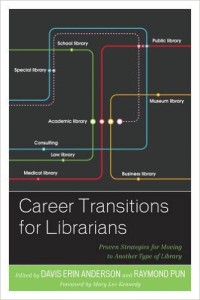 How often have you heard the often-repeated statement that if you’re an “ABC librarian,” you’ll never be able to transition into being an “XYW librarian?” As in, if you’re a public librarian, you’ll never be able to get a job in academia, or special libraries. If you’re in a corporate library, you’d never be considered for school or public.
How often have you heard the often-repeated statement that if you’re an “ABC librarian,” you’ll never be able to transition into being an “XYW librarian?” As in, if you’re a public librarian, you’ll never be able to get a job in academia, or special libraries. If you’re in a corporate library, you’d never be considered for school or public.
Among the grad students I work with, this silo effect is such an accepted fact of life that it causes them to overweight the importance of every early-career decision they make.
But is it true?
Not according to the more than three dozen LIS professionals who’ve contributed their career-transition success stories to Career Transitions for Librarians: Proven Strategies for Moving to Another Type of Library.
Edited by Davis Erin Anderson and Raymond Pun, this collection combines the best of career-transition strategy and tactics, inspiration, insights, and down-to-earth personal narratives in a manner likely to resonate with anyone currently contemplating this type of career move.
Which Direction?
Within broad categories, the book profiles these career moves or transitions:
- Specialized to academic
- Academic to specialized
- Specialized to public
- Public to academic
- Academic to public
- Public to special
- School to academic and vendor services
- Within the academic library world
The actual types of work undertaken by the contributors, however, are quite a bit more fascinating than their categories indicate, for example:
- Art librarian to teen services
- Prison librarian to public
- Public librarian to community college
- Public librarian to news/media
- School library media specialist to technical support
- Medical librarian to science-engineering
Which Approach?
Woven throughout each of these profiles is a wealth of insights about the process of bridging into your target type of librarianship. Some are anecdotal, while others are laid out in a more prescriptive format. Editor/contributor Raymond Pun, for example, provides six “tips for those public librarians who would like to transition into academic librarianship in the future” plus a bulleted list of key points. Others, such as the interview with Lisa Chow and Sandra Sajonas, LIS consultants, have a more iterative, lessons-learned style.
Both approaches work well, and these free-flowing narratives not only allow the contributors to share what they feel will be most valuable, but also make it clear to readers that there’s no one “right way” for transitioning into a new library environment; instead, there are many, depending on your personality and circumstances.
A chapter of profiles on “Nontraditional transitions, internships, and general advice” rounds out the collection, followed by a fascinating description of the contributors and their bios. Reading about these individuals and where they have ended up is itself one of the most compelling arguments for the ability to construct a multi-pathed, diverse LIS career in this age of ongoing disruption and dislocation in the field.
Thank you to Davis Erin Anderson and Raymond Pun for assembling these narratives; Career Transitions for Librarians will be a great resource to have handy as we all move through the stages of our LIS careers.
Career Transitions for Librarians: Proven Strategies for Moving to Another Type of Library. Davis Erin Anderson and Raymond Pun, eds. Rowman & Littlefield, 2016. 253p. ISBN 978-1442263727.
